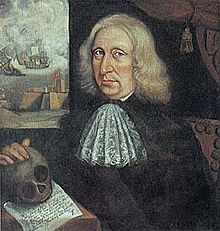Thomas Smith (painter)
Thomas Smith (born before 1675; died after 1690), was an English sailor and captain in the 17th century, who also worked as a portrait painter in the Boston area of New England from 1675 to 1690 , the origin of English colonization North America.
First artist known by name from the English colonies
The first portrait of the English colonies in North America that can be assigned to a local artist known by name comes from Captain Thomas Smith. It was probably made on site in Boston around 1680 and is a self-portrait that is signed as a special feature and depicts the Memento Mori motif. Thomas Smith can be identified as an English Puritan by the strict clothing on his portrait . In the background, elements of Baroque Dutch painting can be heard in the depicted naval battle. The sea motif also refers to the profession of sea captain.
The painter's work
Another portrait attributed to Captain Thomas Smith in addition to the self-portrait is the portrait of Maria Catherine Smith, his daughter. The portrait of the daughter follows even more baroque representations in terms of form and clothing. According to experts, the picture taken ten years after the self-portrait shows that Captain Thomas Smith had developed further as a painter and adapted to a new zeitgeist.
Both paintings are relatively skillfully executed. Along with other clues as to the timing of the assignment of the portrait of Maria Catherine Smith to Captain Thomas Smith and genealogical research, Captain Thomas Smith is mostly confirmed as the painter of both portraits. However, in recent times some experts attribute the picture of Maria Catherine Smith to a different painter than Captain Thomas Smith because of stylistic differences in detail.
In addition to the signed self-portrait, the following portraits preserved from the early colonial period are generally assigned to Captain Thomas Smith due to stylistic similarities:
- Self portrait . Around 1680. Worcester Art Museum , Worcester, Massachusetts (inventory number 1948.19)
- Maria Catherine Smith . Around 1690/93. American Antiquarian Society, Worcester, Massachusetts
- Captain George Curwin . About 1675. Peabody Essex Museum, Salem, Massachusetts
- Portrait of a Man (possibly Elisha Hutchinson). Harvard University Portrait Collection, Cambridge, Massachusetts
- Major Thomas Savage . 1679 (dated). Museum of Fine Arts, Boston (inventory number 1983.35)
- Captain Richard Patteshall . Around 1679 (private property)
- Mrs. Martha Patteshall (née Woody) with child . Around 1679. Museum of Fine Arts, Boston (inventory number 1994.255)
Also, based on documents, it is believed that Captain Thomas Smith was the painter of at least two other portraits now lost. The copy of a portrait of William Ames commissioned by him for Harvard College around 1680 is considered lost. It is also suspected after document analysis that Captain Thomas Smith had painted a portrait of his own wife, which stylistically belonged to the self-portrait.
Art historical classification
The eagerness to find a name and to show the art-historical significance of the first almost naive painters of the New Colonies from Europe is not without controversy. At least a study of the early portraits, most of which were done by local artisans no longer known by name, the so-called Limners or artful amateurs without formal training such as Captain Thomas Smith, can reveal the need for self-expression that emanated from families who lived in the After the years of construction, the colony achieved some wealth for the first time from 1670 and claimed leadership at the economic, political and military level.
Web links
Individual evidence
- ↑ Max Cavitch: interiority and Artifact: Death and Self-Inscription in Thomas Smith's Self-Portrait . In: Early American Literature 37/1 (2002), pp. 89-117.
- ↑ James Thomas Flexner: History of American Painting Volume 1: First Flowers of Our Wilderness . Boston 1947, p. 19; Jules David Prown: American Painting from Its Beginnings to the to the Armory Show . Cleveland 1969, pp. 19-21.
- ^ Louisa Dresser: Seventeenth Century Painting in New England . Worcester, MA, 1935, pp. 136-140.
- ^ Louis B. Wright: The Cultural Life of the American Colonies . Toronto 2002. p. 208; James Thomas Flexner: History of American Painting Volume 1: First Flowers of Our Wilderness . Boston 1947, p. 18.
- ↑ Alan Burroughs: limners and Like Esses. Three Centuries of American Painting . Cambridge. MA, 1936, p. 13.
- ↑ Wayne Craven: Colonial American Portraiture . Cambridge 1986, p. 116; Wayne Craven: American Art: History and Culture . New York 1994, p. 116.
- ↑ Orrando Perry Dexter: Dexter Genealogy . New York 1904, pp. 36-39.
- ^ Alan Wallach: American Art: History and Culture by Wayne Craven (review). In: The Pennsylvania Magazine of History and Biography 119: 1/2 (1995), pp. 164-166.
- ^ Louis B. Wright: The Cultural Life of the American Colonies . Dover 2002, p. 108.
| personal data | |
|---|---|
| SURNAME | Smith, Thomas |
| BRIEF DESCRIPTION | English sailor and captain, portrait painter |
| DATE OF BIRTH | before 1675 |
| DATE OF DEATH | after 1690 |
